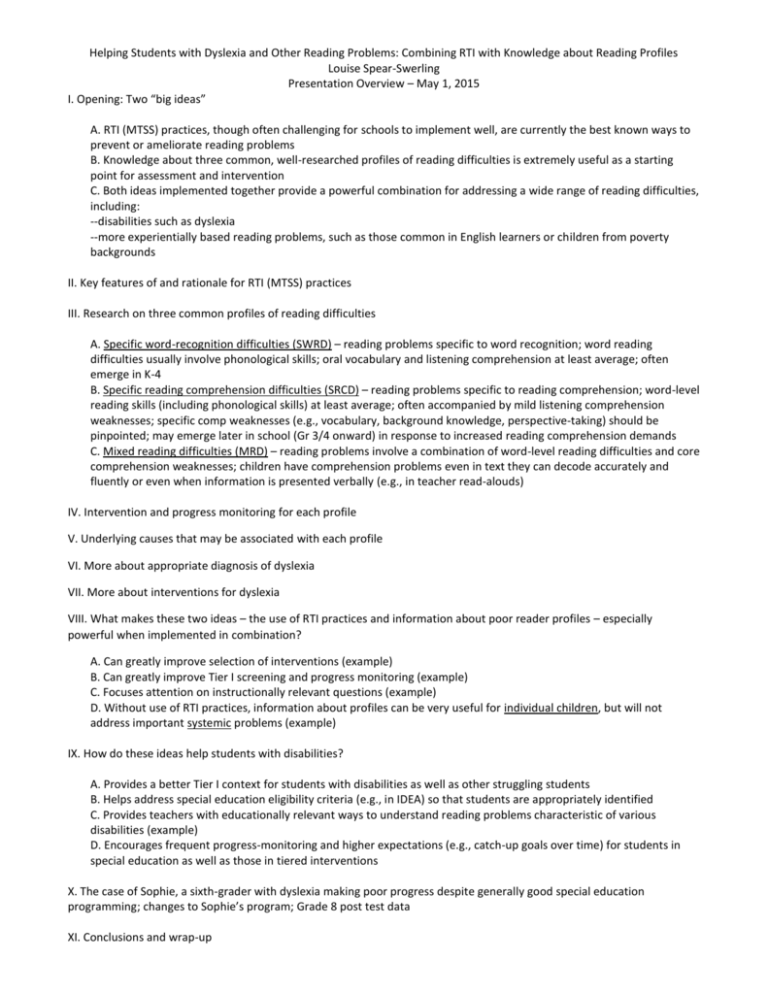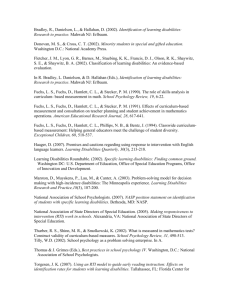Helping Students with Dyslexia and Other Reading Problems
advertisement

Helping Students with Dyslexia and Other Reading Problems: Combining RTI with Knowledge about Reading Profiles Louise Spear-Swerling Presentation Overview – May 1, 2015 I. Opening: Two “big ideas” A. RTI (MTSS) practices, though often challenging for schools to implement well, are currently the best known ways to prevent or ameliorate reading problems B. Knowledge about three common, well-researched profiles of reading difficulties is extremely useful as a starting point for assessment and intervention C. Both ideas implemented together provide a powerful combination for addressing a wide range of reading difficulties, including: --disabilities such as dyslexia --more experientially based reading problems, such as those common in English learners or children from poverty backgrounds II. Key features of and rationale for RTI (MTSS) practices III. Research on three common profiles of reading difficulties A. Specific word-recognition difficulties (SWRD) – reading problems specific to word recognition; word reading difficulties usually involve phonological skills; oral vocabulary and listening comprehension at least average; often emerge in K-4 B. Specific reading comprehension difficulties (SRCD) – reading problems specific to reading comprehension; word-level reading skills (including phonological skills) at least average; often accompanied by mild listening comprehension weaknesses; specific comp weaknesses (e.g., vocabulary, background knowledge, perspective-taking) should be pinpointed; may emerge later in school (Gr 3/4 onward) in response to increased reading comprehension demands C. Mixed reading difficulties (MRD) – reading problems involve a combination of word-level reading difficulties and core comprehension weaknesses; children have comprehension problems even in text they can decode accurately and fluently or even when information is presented verbally (e.g., in teacher read-alouds) IV. Intervention and progress monitoring for each profile V. Underlying causes that may be associated with each profile VI. More about appropriate diagnosis of dyslexia VII. More about interventions for dyslexia VIII. What makes these two ideas – the use of RTI practices and information about poor reader profiles – especially powerful when implemented in combination? A. Can greatly improve selection of interventions (example) B. Can greatly improve Tier I screening and progress monitoring (example) C. Focuses attention on instructionally relevant questions (example) D. Without use of RTI practices, information about profiles can be very useful for individual children, but will not address important systemic problems (example) IX. How do these ideas help students with disabilities? A. Provides a better Tier I context for students with disabilities as well as other struggling students B. Helps address special education eligibility criteria (e.g., in IDEA) so that students are appropriately identified C. Provides teachers with educationally relevant ways to understand reading problems characteristic of various disabilities (example) D. Encourages frequent progress-monitoring and higher expectations (e.g., catch-up goals over time) for students in special education as well as those in tiered interventions X. The case of Sophie, a sixth-grader with dyslexia making poor progress despite generally good special education programming; changes to Sophie’s program; Grade 8 post test data XI. Conclusions and wrap-up References Aaron, P. G., Joshi, M., Gooden, R., & Bentum, K. (2008). Diagnosis and treatment of reading disabilities based on the component model of reading: An alternative to the discrepancy model of LD. Journal of Learning Disabilities, 41, 6784. Allington, R. L., & McGill-Franzen, A. (2008). Comprehension difficulties among struggling readers. In S. E. Israel & G. G. Duffy (Eds.), Handbook of Research on Reading Comprehension (pp. 551-568). New York: Routledge. Badian, N. (1999). Reading disability defined as a discrepancy between listening and reading comprehension. Journal of Learning Disabilities, 32, 138-148. Berninger, V. W., & Wolf, B. J. (2009). Teaching students with dyslexia and dysgraphia: Lessons from teaching and science. Baltimore, MD: Brookes. Brown-Chidsey, R., & Steege, M. (2005). Response to intervention: Principles and strategies for effective practice. New York: Guilford. Cain, K., & Oakhill, J. (2008). Children’s comprehension problems in oral and written language: A cognitive perspective. New York: Guilford. Carnine, D. W., Silbert, J., Kame’enui, E. J., & Tarver, S. G. (2004). Direct instruction reading (4th edition). Upper Saddle River, NJ: Pearson. Catts, H.W., Adlof, S.M., & Weismer, S.E. (2006). Language deficits in poor comprehenders: A case for the simple view of reading. Journal of Speech, Language, and Hearing Research, 49(2), 278-293. Catts, H.W., Compton, D.L., et al. (2012). Prevalence and nature of late-emerging poor readers. Journal of Educational Psychology, 104(2), 166-181. Clarke, P. J., Snowling, M. J., Truelove, E., & Hulme, C. (2010). Ameliorating children’s reading-comprehension difficulties: A randomized controlled trial. Psychological Science, 21, 1106-1116. Compton, D.L., Fuchs, L.S., Fuchs, D., Lambert, W., & Hamlett, C. (2012). The cognitive and academic profiles of reading and mathematics learning disabilities. Journal of Learning Disabilities, 45(1), 79–95. Cutting, L. E., Clements-Stephens, A., Pugh, K. R., Burns, S., Cao, A., Pekar, J. J., et al. (2013). Not all reading disabilities are dyslexia: Distinct neurobiology of specific comprehension deficits. Brain Connectivity, 3, 199-211. Denton, C. A., Fletcher, J. M., Anthony, J. L., and Francis, D. J. (2006). An evaluation of intensive intervention for students with persistent reading difficulties. Journal of Learning Disabilities, 39, 447-466. Erickson, K. (2013). Reading and assistive technology: Why the reader’s profile matters. Perspectives on Language and Literacy, 39, 11-14.Fletcher, J. M., Lyon, G. R., Fuchs, L. S., & Barnes, M. A. (2007). Learning disabilities: From identification to intervention. New York: Guilford. Fuchs, D., Fuchs, L. S., & Compton, D. L. (2012). Smart RTI: A next-generation approach to multilevel prevention. Exceptional Children, 78, 263-279. Fuchs, D., Fuchs, L. S., & Stecker, P. M. (2010). The “blurring” of special education in a new continuum of general education placements and services. Exceptional Children, 76, 301-323. Huemer, S. V., & Mann, V. (2010). A comprehensive profile of decoding and comprehension in autism spectrum disorders. Journal of Autism and Developmental Disorders, 40, 485-493. Kieffer, M. J. (2010). Socioeconomic status, English proficiency, and late-emerging reading difficulties. Educational Researcher, 39, 484-486. Leach, J. M., Scarborough, H. S., & Rescorla, L. (2003). Late-emerging reading disabilities. Journal of Educational Psychology, 95, 211-224. Lesaux, N. K., & Kieffer, M. J. (2010). Exploring sources of reading comprehension difficulties among language minority learners and their classmates in early adolescence. American Educational Research Journal, 47, 596-632. Nation, K., Clarke, P., Wright, B., & Williams, C. (2006). Patterns of reading ability in children with autism spectrum disorder. Journal of Autism and Developmental Disorders, 36, 911-919. Norbury, C., & Nation, K. (2011). Understanding variability in reading comprehension in adolescents with autism spectrum disorders: Interactions with language status and decoding skill. Scientific Studies of Reading, 15, 191-210. Scarborough, H. S. (2005). Developmental relationships between language and reading: Reconciling a beautiful hypothesis with some ugly facts. In H. W. Catts & A. Kamhi (Eds.), The connections between language and reading disabilities (pp. 3-24). Mahwah, NJ: Erlbaum. Spear-Swerling, L. (2004). Fourth-graders’ performance on a state-mandated assessment involving two different measures of reading comprehension. Reading Psychology, 25, 121-148. Spear-Swerling, L. (2015). The power of RTI and reading profiles: A blueprint for solving reading problems. Baltimore, MD: Brookes. Valencia, S. W. (2011). Reader profiles and reading disabilities. In In R. Allington & A. McGill-Franzen (Eds.), Handbook of research on reading disabilities (pp. 25-35). New York: Routledge.






